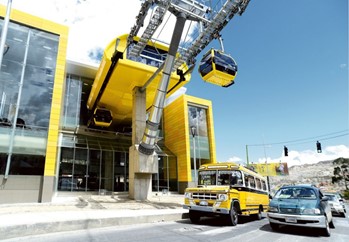This content was originally published on LANCOMWIRE: The LANCOM Systems Tech Blog.
Urban spaces are sprouting up like mushrooms, growing beyond their boundaries and presenting completely new challenges in terms of mobility and infrastructure. Mobility as we know it today, with overcrowded streets and poor air quality, is a model that has had its day.
Climate goals aside, urban transport networks are barely keeping pace with the enormous numbers of commuters who move around each day. If we consider Latin America, with the high altitudes of Bolivia’s capital La Paz or the Mexican metropolises, the models being implemented may well inspire urban future-proof mobility concepts for other cities in the long term: Modern cable car systems that traverse many different city plateaus. From the high altitude regions of the Alps, for example, we are familiar with gondolas and cable car systems that are networked with the latest technology. But what requirements does the network have to meet in urban areas?
Up high in Latin America

© Doppelmayr Seilbahnen GmbH
Mi Teleférico, which translates from Spanish as “my cable car,” has connected the Bolivian cities of La Paz and El Alto since 2014. In this case, the Austrian cable car manufacturer Doppelmayr/Garaventa has built the world’s largest urban cable car network. Consisting of ten lines in total, the cable car network offers daily commuters a faster way to reach their destinations. Some sections of the system negotiate up to 666 meters of difference in altitude. It wouldn’t work without the latest technology: For the security-related applications and additional service offerings for passengers, a stable Wi-Fi® network is essential. The requirements of a Wi-Fi for urban cable cars like those in La Paz are extremely tough. On the one hand, the network has to control safety-related applications, such as the intercom system in the gondolas, security cameras and lighting control, as well as the monitoring of the pylons and battery systems. On the other hand, passengers in the gondola expect Wi-Fi with a strong and stable signal. With travel times of up to half an hour, a seamless Wi-Fi network offers even more convenience.
Networks at the cutting edge
The implementation of a network over a total distance of 30 kilometers required the setup of a communication system consisting of Wi-Fi access points and directional radio antennas. In La Paz, each cable car pylon and each individual gondola is equipped with a dual-radio outdoor Wi-Fi access point. The altitudes involved demand special hardware for the networks. Thanks to their IP66 protective housing, outdoor access points work reliably in temperatures ranging from -33° to +70° Celsius and withstand the weather with its snow, dust and the cold of the Andes. The APs are equipped with directional antennas to specifically focus the Wi-Fi signal along the path taken by the gondolas. Each gondola is also fitted with an AP that receives the signal and forwards it to the Mobility Communications System (MCS)—in this case a central system designed by LOOP21. The central communication system replaces, among other things, the radio technology required for the alarm and safety system. To ensure seamless wireless connectivity for the communication system, it is particularly important that the directional radio antennas of the OAPs are aligned precisely.
Requirements in airy heights
The demands on a network in urban areas are great: it has to handle long distances, extreme differences in altitude, and different sources of interference from radio networks. And the wireless network is just as scalable as the cable car network itself. New sections of a route can be quickly and easily provided with Wi-Fi and integrated into the overall network.
As a model for the mobility of the future, urban cable cars like those in Latin America are a role model for metropolitan regions that are reaching their limits of their infrastructure. Thanks to modern network technology that combines passenger convenience with important security requirements, future viability is guaranteed.
All pictures were provided by Doppelymayr Seilbahnen GmbH.
The statements and opinions by each Wi-Fi Alliance member and those providing comments are theirs alone, and do not reflect the opinions or views of Wi-Fi Alliance or any other member. Wi-Fi Alliance is not responsible for the accuracy of any of the information provided by any member in posting to or commenting on this blog. Concerns should be directed to info@wi-fi.org.




Add new comment